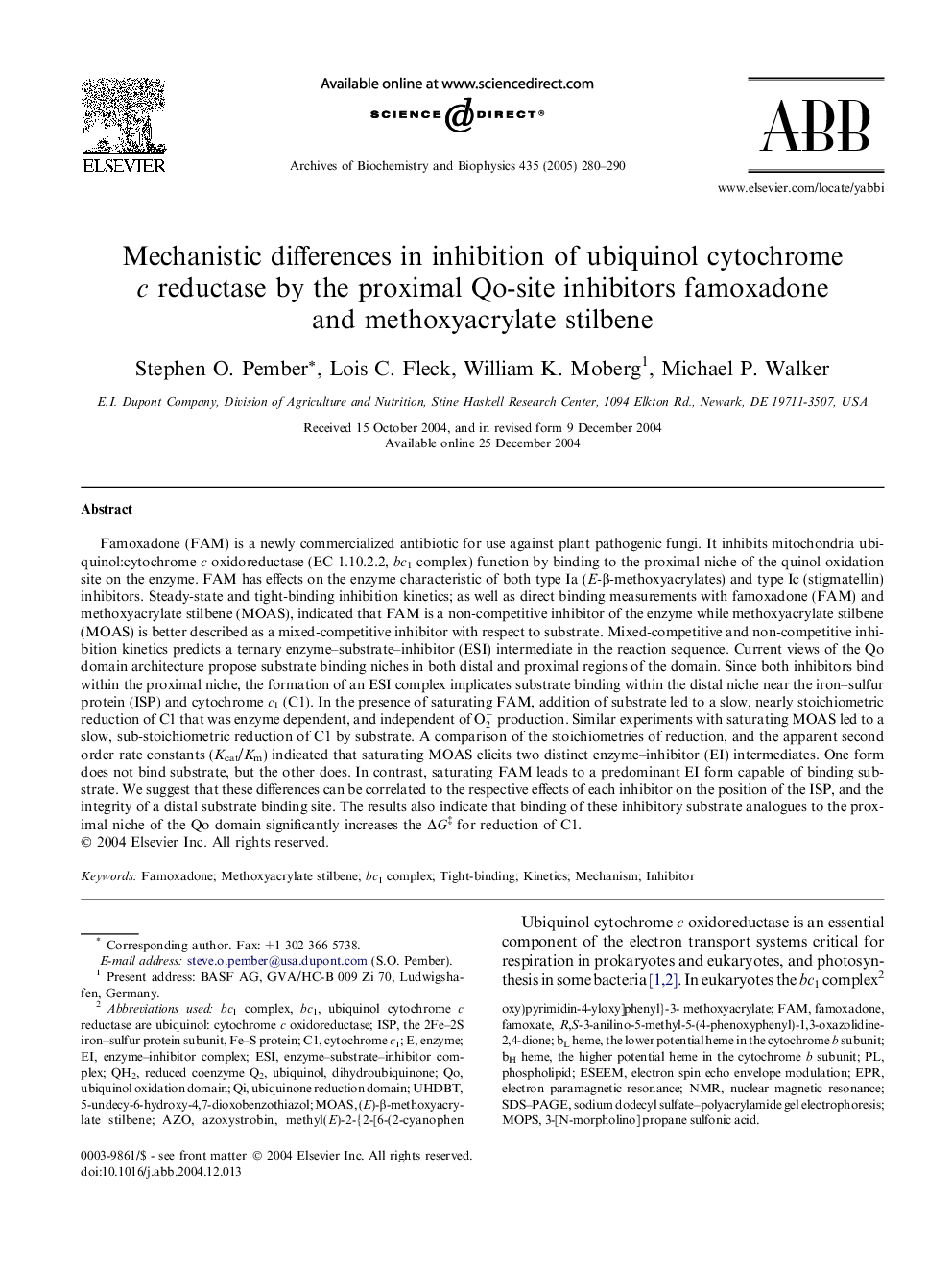| کد مقاله | کد نشریه | سال انتشار | مقاله انگلیسی | نسخه تمام متن |
|---|---|---|---|---|
| 9882288 | 1536552 | 2005 | 11 صفحه PDF | دانلود رایگان |
عنوان انگلیسی مقاله ISI
Mechanistic differences in inhibition of ubiquinol cytochrome c reductase by the proximal Qo-site inhibitors famoxadone and methoxyacrylate stilbene
دانلود مقاله + سفارش ترجمه
دانلود مقاله ISI انگلیسی
رایگان برای ایرانیان
کلمات کلیدی
موضوعات مرتبط
علوم زیستی و بیوفناوری
بیوشیمی، ژنتیک و زیست شناسی مولکولی
زیست شیمی
پیش نمایش صفحه اول مقاله

چکیده انگلیسی
Famoxadone (FAM) is a newly commercialized antibiotic for use against plant pathogenic fungi. It inhibits mitochondria ubiquinol:cytochrome c oxidoreductase (EC 1.10.2.2, bc1 complex) function by binding to the proximal niche of the quinol oxidation site on the enzyme. FAM has effects on the enzyme characteristic of both type Ia (E-β-methoxyacrylates) and type Ic (stigmatellin) inhibitors. Steady-state and tight-binding inhibition kinetics; as well as direct binding measurements with famoxadone (FAM) and methoxyacrylate stilbene (MOAS), indicated that FAM is a non-competitive inhibitor of the enzyme while methoxyacrylate stilbene (MOAS) is better described as a mixed-competitive inhibitor with respect to substrate. Mixed-competitive and non-competitive inhibition kinetics predicts a ternary enzyme-substrate-inhibitor (ESI) intermediate in the reaction sequence. Current views of the Qo domain architecture propose substrate binding niches in both distal and proximal regions of the domain. Since both inhibitors bind within the proximal niche, the formation of an ESI complex implicates substrate binding within the distal niche near the iron-sulfur protein (ISP) and cytochrome c1 (C1). In the presence of saturating FAM, addition of substrate led to a slow, nearly stoichiometric reduction of C1 that was enzyme dependent, and independent of O2- production. Similar experiments with saturating MOAS led to a slow, sub-stoichiometric reduction of C1 by substrate. A comparison of the stoichiometries of reduction, and the apparent second order rate constants (Kcat/Km) indicated that saturating MOAS elicits two distinct enzyme-inhibitor (EI) intermediates. One form does not bind substrate, but the other does. In contrast, saturating FAM leads to a predominant EI form capable of binding substrate. We suggest that these differences can be correlated to the respective effects of each inhibitor on the position of the ISP, and the integrity of a distal substrate binding site. The results also indicate that binding of these inhibitory substrate analogues to the proximal niche of the Qo domain significantly increases the ÎGâ¡ for reduction of C1.
ناشر
Database: Elsevier - ScienceDirect (ساینس دایرکت)
Journal: Archives of Biochemistry and Biophysics - Volume 435, Issue 2, 15 March 2005, Pages 280-290
Journal: Archives of Biochemistry and Biophysics - Volume 435, Issue 2, 15 March 2005, Pages 280-290
نویسندگان
Stephen O. Pember, Lois C. Fleck, William K. Moberg, Michael P. Walker,